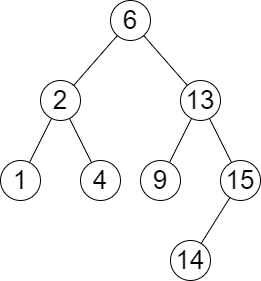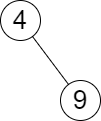You are given the root of a binary search tree and an array queries of size n consisting of positive integers.
Find a 2D array answer of size n where answer[i] = [mini, maxi]:
mini is the largest value in the tree that is smaller than or equal to queries[i]. If a such value does not exist, add -1 instead.
maxi is the smallest value in the tree that is greater than or equal to queries[i]. If a such value does not exist, add -1 instead.
Return the array answer.
Example 1:

Input: root = [6,2,13,1,4,9,15,null,null,null,null,null,null,14], queries = [2,5,16]
Output: [[2,2],[4,6],[15,-1]]
Explanation: We answer the queries in the following way:
- The largest number that is smaller or equal than 2 in the tree is 2, and the smallest number that is greater or equal than 2 is still 2. So the answer for the first query is [2,2].
- The largest number that is smaller or equal than 5 in the tree is 4, and the smallest number that is greater or equal than 5 is 6. So the answer for the second query is [4,6].
- The largest number that is smaller or equal than 16 in the tree is 15, and the smallest number that is greater or equal than 16 does not exist. So the answer for the third query is [15,-1].
Example 2:

Input: root = [4,null,9], queries = [3]
Output: [[-1,4]]
Explanation: The largest number that is smaller or equal to 3 in the tree does not exist, and the smallest number that is greater or equal to 3 is 4. So the answer for the query is [-1,4].
Constraints:
The number of nodes in the tree is in the range [2, 105].
1 <= Node.val <= 106
n == queries.length
1 <= n <= 105
1 <= queries[i] <= 106
二叉搜索树最近节点查询。
给你一个 二叉搜索树 的根节点 root ,和一个由正整数组成、长度为 n 的数组 queries 。
请你找出一个长度为 n 的 二维 答案数组 answer ,其中 answer[i] = [mini, maxi] :
mini 是树中小于等于 queries[i] 的 最大值 。如果不存在这样的值,则使用 -1 代替。
maxi 是树中大于等于 queries[i] 的 最小值 。如果不存在这样的值,则使用 -1 代替。
返回数组 answer 。
思路
这里我先提供一个次优解,思路是用treeset将二叉搜索树中的所有节点记录下来,然后利用 treeset 里的 ceiling 和 floor 两个特别的函数去分别找到比目标小的数字中的最大的和比目标大的数字中的最小的。
复杂度
时间O(nlogn) - 为什么有 nlogn 是因为 treeset 有排序的动作
空间O(n)
代码
Java实现
/**
* Definition for a binary tree node.
* public class TreeNode {
* int val;
* TreeNode left;
* TreeNode right;
* TreeNode() {}
* TreeNode(int val) { this.val = val; }
* TreeNode(int val, TreeNode left, TreeNode right) {
* this.val = val;
* this.left = left;
* this.right = right;
* }
* }
*/
class Solution {
public List<List<Integer>> closestNodes(TreeNode root, List<Integer> queries) {
TreeSet<Integer> set = new TreeSet<>();
helper(root, set);
List<List<Integer>> res = new ArrayList<>();
int n = queries.size();
for (int i = 0; i < n; i++) {
int val = queries.get(i);
List<Integer> list = new ArrayList<>();
if (set.floor(val) != null) {
list.add(set.floor(val));
} else {
list.add(-1);
}
if (set.ceiling(val) != null) {
list.add(set.ceiling(val));
} else {
list.add(-1);
}
res.add(list);
}
return res;
}
private void helper(TreeNode root, TreeSet<Integer> set) {
if (root == null) {
return;
}
set.add(root.val);
helper(root.left, set);
helper(root.right, set);
}
}